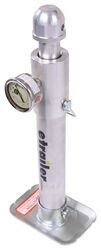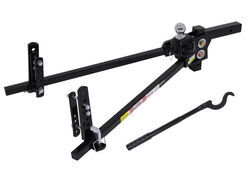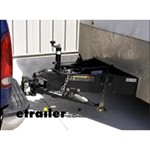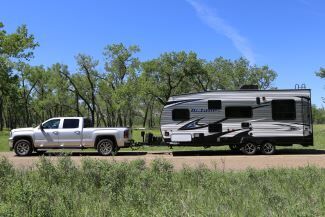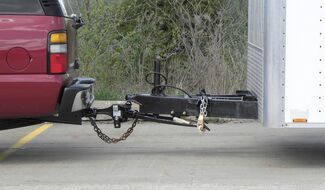
Comparing Electronic Sway Control vs WD Systems with Sway Control
Question:
New to trailering, so please excuse the ignorance. 2014 F150 supercrew, 3.5 eb, trailer tow package. Looking at a trailer that weighs approx. 6000 lbs, with a 600 lb tongue weight. I understand i need a wd hitch as the factory hitch has a 500 lb max tongue weight capacity. My question is: I see wd hitches with and without sway control. I know the truck has electronic sway control as standard. Should I just get a wd hitch, or one with sway control as well. WIll it tow more easily with the sway control, or will the two systems fight each other? This will be my first trailer, so anything that makes it easier\safer is what I would be looking for. Thank you for your advice.
asked by: Joe A
Expert Reply:
Thanks for asking a very good question; I am happy to offer some help.
Electronic sway-control systems, whether they are OEM or aftermarket, do not deliver the same level of sway-control performance you can get from a weight distribution (WD) system that has this anti-sway feature built in.
The reason is that the electronic systems only start to work once sway has begun. They detect the sway and then apply the brakes selectively in an attempt to reduce that sway. Vehicle systems apply the truck brakes; trailer-mounted systems like the Hayes apply the trailer brakes to try to overcome the sway. Both help wear out your brakes faster.
The better WD systems actually prevent sway, rather than try to deal with it after it starts. And you are correct that it is generally not good to use both a WD system with sway control and an electronic system. You might care to check out the linked article and video which include lots of useful information on WD setups.
The key to selecting the right WD/SC system is knowing the trailer's actual tongue weight (TW) when it is fully loaded and ready for the road, with full propane and water tanks and all your gear and supplies loaded. We offer a scale # e99044 that makes this measurement process easy. To this loaded TW you need to add the weight of any cargo in the truck that sits behind the rear axle, such as a generator or loaded cooler, to get your total TW. The ideal situation is that your actual total TW falls in the middle of the operating range for the WD system.
For instance, Equal-I-zer system # EQ37100ET works over a TW range from 600- to 1000-lbs so it would be perfect for a loaded TW of 800-lbs. For an actual total TW of 1000-lbs the system # EQ37120ET would be better since it is intended for a TW range of 800- to 1,200-lbs. Equal-I-zer systems are all-inclusive.

Products Referenced in This Question
etrailer Tongue Weight Scale for Campers and Utility Trailers - 2,000-lb Capacity
- Tongue Weight Scale
- Analog Scale
- 2000 lbs
- etrailer
more information >
Equal-i-zer Weight Distribution System w/ 4-Point Sway Control - 10,000 lbs GTW, 1,000 lbs TW
- Weight Distribution Hitch
- WD With Sway Control
- Some Sway
- Includes Shank
- Electric Brake Compatible
- Surge Brake Compatible
- Fits 2 Inch Hitch
- Allows Backing Up
- 800 lbs
- 900 lbs
- Equal-i-zer
more information >
Product Page this Question was Asked From
Equal-i-zer Weight Distribution System w/ 4-Point Sway Control - 12,000 lbs GTW, 1,200 lbs TW
- Weight Distribution Hitch
- WD With Sway Control
- Some Sway
- Includes Shank
- Electric Brake Compatible
- Surge Brake Compatible
- Fits 2 Inch Hitch
- Allows Backing Up
- 1000 lbs
- 1100 lbs
- Equal-i-zer
more information >
Featured Help Information
Instructions
Miscellaneous Media

Continue Researching
- Article: 2 Steps for Finding the Right Weight Distribution Hitch Size
- Video: Equal-i-zer Weight Distribution - WD With Sway Control - EQ37120ET Review
- Article: How to Measure for Trailer Hitch Drop
- Shop: Equal-i-zer Weight Distribution System w/ 4-Point Sway Control - 12,000 lbs GTW, 1,200 lbs TW
- Search Results: equal~i~zer weight distribution hitch
- Search Results: tongue weight scale
- Q&A: Does Weight Distribution Lower Tongue Weight on Hitch of Tow Vehicle
- Q&A: Equal-i-zer Hitch Shank that Can be Used in 2-1/2 inch Hitch
- Q&A: How to Choose Correctly-Rated Weight Distribution Hitch
- Q&A: Can You Back Up When Using Equalizer Hitch # EQ37120ET
- Q&A: Does the Equal-i-zer Weight Distribution System Come With a 2 Inch Hitch Ball
- Q&A: Equal-I-Zer Weight Distribution Recommendation for Trailer with GVWR of 8,300 lb
- Q&A: Travel Trailer Towed By 2021 Chevy Silverado 1500 Bounces Uncontrollably
- Shop: Trailer Wiring
- Shop: Brake Controller
- Shop: Hollywood Racks Destination E Bike Rack for 2 Electric Bikes - 2" Hitches - Frame Mount
- Shop: Trailer Hitch
- Video: Draw-Tite Max-Frame Trailer Hitch Installation - 2019 GMC Terrain
- Shop: Towing Mirrors
- Shop: Suspension Enhancement
- Shop: Draw-Tite Max-Frame Trailer Hitch Receiver - Custom Fit - Class III - 2"
- Article: Wiring Trailer Lights with a 7-Way Plug (It's Easier Than You Think)
- Shop: Thule EasyFold XT Bike Rack for 2 Electric Bikes - 1-1/4" and 2" Hitches - Frame Mount
- Search Results: trailer tail light kit
- Article: 5 Things to Know About Weight Distribution Hitches
- Video: Hollywood Racks Destination E Bike Rack Review - 2017 Toyota RAV4
- Video: Peterson Trailer Tail Light Kit Review and Installation
- Shop: Curt Auxiliary LED Indicator Lights
- Shop: Peterson Trailer Tail Light Kit - Waterproof - Stop, Turn, Tail - Incandescent - Oval - Red Lens
- Video: K Source Dual Lens Universal Towing Mirrors Review



